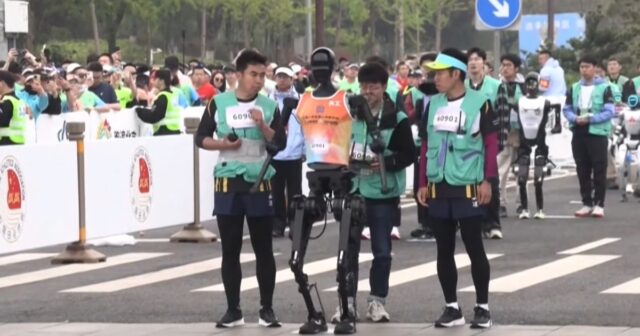You may have seen robots dancing like the music icon Mick Jagger, doing parkour, or even painting on a canvas. Tesla’s Optimus humanoid robot is eagerly anticipated, while Google and Meta are also planning to enter the field. The competition in the East, however, is on a different level altogether.
China just put humanoid robots to the test in the world’s first race of its kind, where they ran alongside humans in a half-marathon. A total of 21 robots lined up for the event in the Yizhuang half-marathon, following a long spell of supervised learning on roads.
The event saw a whole bunch of robotics companies showcase their ware. Some of the robots were as short as 3.9 feet, while others reach a typical human height of 5.9 feet. Some stumbled, a few tried to get back up on their own, while a small number needed human assistance.
During the race, the humanoid robots navigated around steep slopes, potholes, puddles, and smooth asphalt. Battery swaps were allowed, but replacement would incur a steep penalty. Not all robots made it to the finish line, however, despite intervention by robotics and software experts.
Did robots beat humans?
Not really, and the gap was huge, as well. The human victor finished the half-marathon in just over an hour, while the winning humanoid robot took 2 hours and 40 minutes to reach the finish line.
That comes down to an average speed of 4.89 miles per hour. For comparison, Olympic champion Usain Bolt reached a top speed of 27.33 miles per hour at a track event in 2011. Beating a human runner, however, was never the point, even though the winner outperformed the engineering team’s expectations by roughly half an hour.
The half-marathon in China was more like a showcase of progress made by local robotics companies. The winner among the humanoid robots, named Tiangong Ultra, is developed by the Beijing Innovation Center of Human Robotics.
A milestone achievement
“I don’t want to boast but I think no other robotics firms in the West have matched Tiangong’s sporting achievements,” Tang Jian, head of the company behind the winning robot, was quoted as saying by Reuters.
It’s a state-backed company in which Chinese electronics giant Xiaomi is also a key stakeholder. According to SCMP, the company aims to become “the Android in the field of humanoid robots.” For the half-marathon, some modification work was also done to get the best performance.
“We lightened the robot without compromising its strength, refined its leg design, and improved its thermal conductivity and air-cooling systems to boost stability and endurance,” Guo Yijie, a technician for the Tien Kung Ultra robot, told Xinhua.
Participating companies and the organizers behind the unique half marathon note that the ultimate goal is to showcase humanoid robots in human environments. They will soon graduate from design labs to industrial settings, but the ultimate goal is to put them into an average person’s home as a helpful assistant.

















































